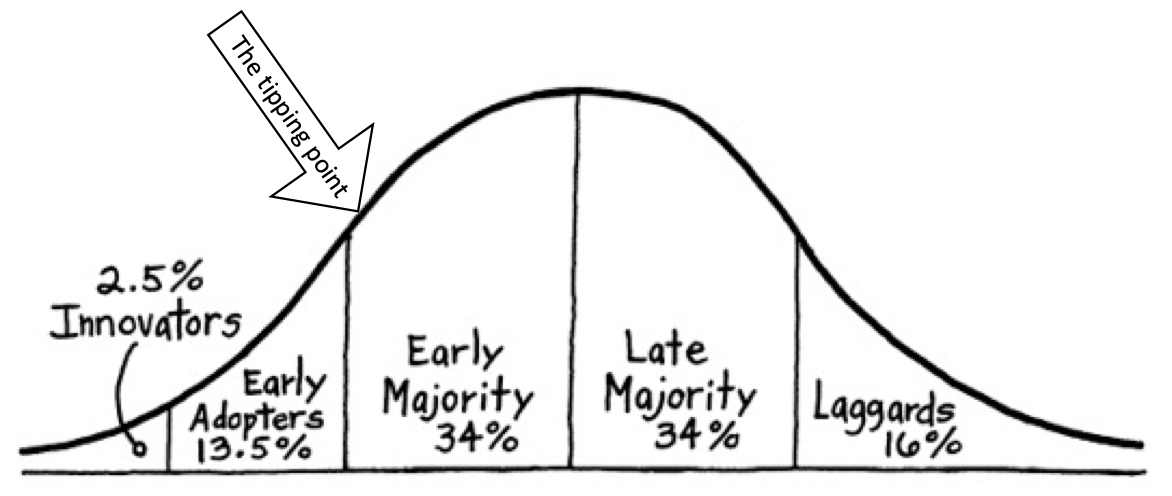Attention revolution: Crossing the audience measurement chasm

Attention (as a metric) has moved to the Early Majority stage on the innovation diffusion curve
You know how it happens: you hear about something new, then you hear a few more people talking about it and then the groundswell happens. People start asking whether you’ve – seen the movie, bought the product, changed your view. But we all know that overnight sensations take years to happen.
Even to me, attention as a metric of ad effectiveness is still relatively new. Many high-profile organisations are talking about and investing in attention, and market mass is still to come. But I don’t think it is that far away
When change is happening, a deep breath and a bit of context helps. For me, Rogers’ Law of Diffusion sets the scene for what is happening across the industry.
The Law of Diffusion (originally Professor Everett Rogers, later popularised by Geoffrey Moore) is the process by which an innovation or product is communicated and accepted over time amongst the participants in a social system or market. Participants in a marketplace fall into one of five groups across the adopter distribution curve):

Innovators (2.5%) pursue new products and/or ideas aggressively and are intrigued by any fundamental advance. Being first is a central part of their lives even if they have very limited proof that the ideas work.
Some very early innovators in the attention economy more than five years ago include Fox, IBM, The Economist, Mondelez, NBCUniversal.
Early adopters (13.5%) are also willing to try new things and recognise the value of new ideas, but they look for more proof than innovators. Often this is because they are opinion leaders, so advocacy is an exchange for future value.
Early adopters are still willing to put up with product imperfection because they can see the potential rewards of adoption. They rely heavily on their educated intuition for this foresight. Attention early adopters include OMD, Mars, Spotify, Microsoft, SC Johnson, Pepsi, Dentsu, and ABInBev.
The Early Majority (34%) will wait to see the reaction of the Early Adopters before they are confident enough to try an innovation. Once this happens, the Fear of Missing Out begins and the early majority move fast.
The Late Majority (34%) are much more hesitant to change, they are risk-averse and will be the last in the market to take on innovations. Certainly not before it’s tested by the Early Majority.
Laggards (16%) will refuse innovation for as long as possible. They would rather put up with the dysfunction of old technology than admit it is worth changing.
The tipping point is when the growth of an innovation starts to gather extraordinary pace.
Mass-market acceptance, in the context of this diffusion, is said to happen when around 15-18% of the market are ready to adopt. This is the point where the innovation is said to have ‘crossed the chasm’.
Where you get enough of the people on the left side of the curve, and they encourage the right side to follow. If you have been leading change, the nice part about the tipping point is that growth becomes easier after that.
Suman Sarkar, author of Customer-Driven Disruption, says that most people think technology drives disruption, but technology merely enables it; the cause is changing customer need. Over the past few months the rate of adoption for attention metrics has gathered pace. The exciting part is that brands are driving this change.
I’m told over and over that brands are asking their agencies, “What is your 2022 attention strategy?” This follows with agencies asking publishers, “How will you deliver what the brands want?”
Adding to this, The Attention Council reported at the July 2021 summit, there had been a significant uptake in usage of attention metrics via a longitudinal cohort of brands and agencies.
One year on, and 55% said they are evaluating media quality using attention metrics, compared to 40% a year ago. More impressively, three times the number of respondents said they are now actually buying or optimising against attention (7% in 2020 to 24% in 2021).
I’m inclined to think that attention (as an applied metric) has moved to the Early Majority stage on the innovation diffusion curve. Which means attention economy is officially crossing the chasm.
But… a cautionary word for Early Adopters. Your job is not done.
Crossing the chasm is a critical time. We continue to need ethical leaders with eyes across the entire ecosystem to ensure that the change is ultimately valuable. You need to be the gatekeepers of quality attention products (accuracy, consistency, transparency) to foster the market evolution. And we need you to continue advocating for a positive economy, not just tweak a few levers and end up in the same space.
The good news is that attention metrics are here to stay. What is your 2022 attention strategy?
Professor Karen Nelson-Field is a media science researcher and founder of Amplified Intelligence. This is a monthly column for Mediatel News in which she explores how brands can activate attention to measure online advertising as well as build a better digital ecosystem.
Email Karen: If you’d like to respond to this article or ask Prof Nelson-Field a question, please email: [email protected]. Please note this email is monitored by Mediatel News.




